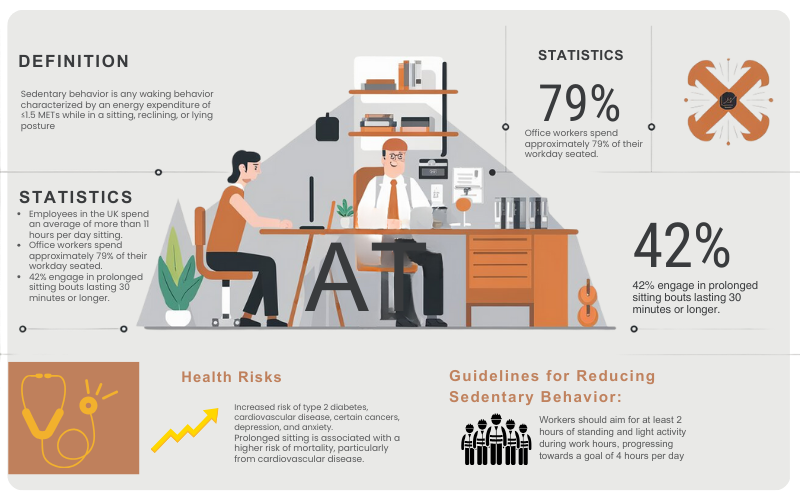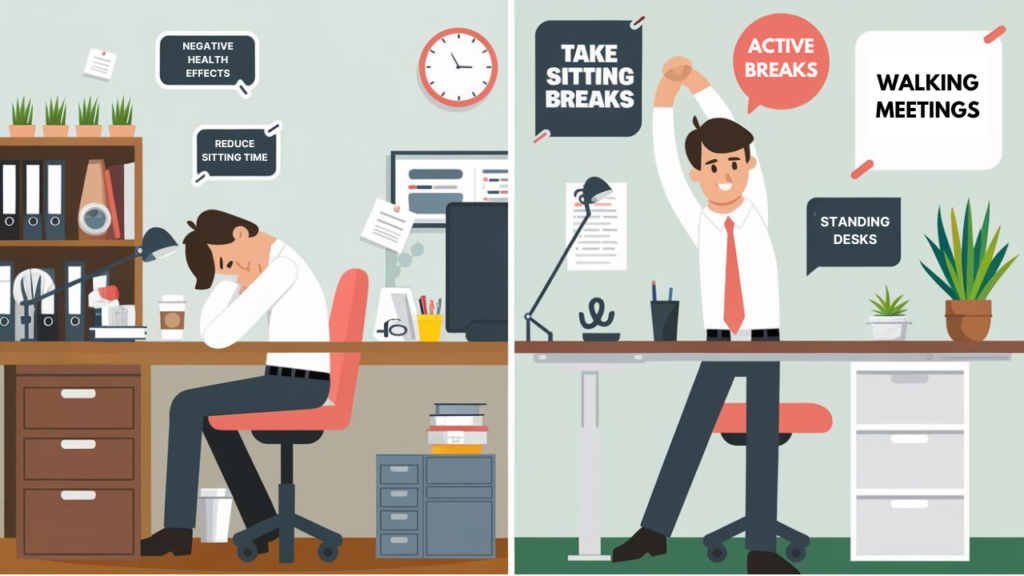Sitting is the silent killer

In this contemporary world, everybody just wants to be successful in their daily life. And so, we hustle to get our work done and cross things off our to-do list. Because of this, we usually sit and work for hours without even a single break, which harms our physical health. Sedentary behavior, such as sitting at a desk, playing video games, and watching TV, which describes low-energy activities, can lead to very serious health problems. They signify a risk of type 2 diabetes, obesity, and cardiovascular disease, and may even cause early death.
There is one study in which we discovered that a person who sat for over 8 hours a day had a 15% chance of dying prematurely than someone who sat for under 4 hours daily. A cardiologist, Naveen Rajpurohit, at the Sanford Cardiovascular Institute, has stated, “Prolonged Sitting (sitting for two hours or more at a time) is the silent killer. It’s slowly affecting our lifestyle.”
But why is Prolonged Sitting such a danger, and how does it quietly wear down our health? Let’s explore how too much sitting can negatively impact our bodies, along with a simple and effective solution to help you break free from the “silent killer” of modern life.
Why Sitting is Called the Silent Killer
Prolonged sitting is also known as the “silent killer” and there is a good reason for it, you do not gain weight instantaneously by sitting too much or notice any noticeable health improvements if you lead a more active lifestyle. It silently ramps up your risk for serious diseases like heart disease, diabetes, and some cancers.
Sitting for long periods has been found to burn fewer calories, slowing blood circulation and making our metabolism less efficient. In the long term, they give rise to a situation called chronic diseases which usually do not have any pronounced early warning. Because sitting is such a stealthy, slow-burning menace to our health.
Research also shows that people who sat for long periods had a higher risk of dying early than their active counterparts—no matter how much those latter folks exercised in their leisure time. So, it is really important to disturb sitting time with daily movements at intervals.
The Effects of Sitting on Your Body:
Physiological Effects

Chronic sitting has serious biological consequences, resulting in disorders such as metabolic dysfunction, musculoskeletal pathology, and heightened risks for stroke and coronary artery disease.
Metabolic Impact
Long hours of sitting can harm our metabolism, such as glucose and insulin sensitivity. Breaking up prolonged sitting is suggested to modulate the hemodynamic response such that specific regions of the brain involved in executive functions become healthier impacting glucose metabolism both at CNS and periphery levels resulting in better response inhibition and information processing speed among adults [source].
In addition, long periods of sitting have been found to result in postprandial hyperglycemia and insulin resistance that can cause damage to the endothelium and cardiovascular system [source]. By interrupting sitting, numerous studies have found significant decreases in body weight and waist circumference all this again strengthens the growth theory on a direct link between a sedentary lifestyle with obesity as summarized in a meta-analysis.
Musculoskeletal Issues
This is because our bodies are not built for long-term static postures. Muscle strain and long-term damage from the unnatural spine positions that accompany prolonged sitting contribute to chronic back pain.[source].
As well as a lack of physical activity, sedentary behavior can also cause muscular imbalance and weaken muscles in particular gluteal and back muscles which result in muscle tightness that decreases mobility so the injury risk can be increased.
Cardiovascular Risks
Long-term sitting is closely linked to cardiovascular health issues. Sitting for in excess of 6 hours has been linked to increased early death risk compared to the other sample size, sitting less than 3 hours. A 2019 investigation identified a significantly higher risk of cardiovascular disease with ≤7 hours per week sitting but increased sedentariness in ≥55 sitter hours concurrently raised CVD danger up to 95% [source]. This is exacerbated by the reduction in blood flow and endothelial dysfunction that can result in high blood pressure, as well as other cardiovascular dangers.
Hormonal Effects
Prolonged -> hormones as well as Hormonal alterations associated with Inactivity that might manifest themselves in Metabolic and Stress responses. For example, the evidence regarding salivary cortisol levels is inconclusive but disrupting prolonged sitting can counteract some of the negative metabolic consequences of obesity and sedentary behavior.[source: 1,2]
Psychological Effects

Mental Health
There is also a critical need to further examine the association between sedentary behavior and mental health. According to a meta-analysis of studies published in Preventive Medicine, increased sedentary behavior was associated with an increased risk for depression and anxiety. Endorphin release for mood regulation required extended periods of rest, and kept activity in the systems meager to nearly non-existent. [Source]
Stress and Mood
Research in psychosomatic medicine shows that after sitting for several hours your ability to focus and cope with stress, and fatigue deteriorates. The main catalyst is the physiological results of a sedentary lifestyle that interferes the other stress management and also helps to enhance anxiety.
Creativity and Cognitive Performance
Sedentary time is horrible for brain function and creativity. Longitudinal associations emerged between sitting…and improved or sustained mood, anxiety, and psychotic disorders over time among those with the impression of mental illnesses,… as well as improvement in depressive symptoms over time.
Notably, levels of mental distress generally tended to be highest among younger adults and females — indicating demographic differences in the psychological burden of sitting for extended periods. [Source1,2]
Interrelation with COVID-19
The COVID-19 pandemic has increased sedentary behavior while negatively impacting mental health for most. The interplay between physical activity and mental health is underscored by a longitudinal study that revealed an attenuation in the recovery of depressive symptoms among those who self-reported more sitting during the pandemic. Taken together, the results hint at a self-perpetuating cycle in which an inactive life not only fuels anxiety and depression but also exacerbates such symptoms.

Health Recommendations
Interventions to Reduce Sitting Time
To lessen the negative health effects of too much sitting, various strategies have been tried and tested. These include:
- Phone Reminders: Setting up alerts to remind you to stand up and move.
- Task-Based Prompts: Incorporating cues into your work tasks that encourage movement.
These approaches have been effective in reducing overall sitting time and promoting intentional walking during work hours.
Workplace Strategies
Practical changes in the workplace can make a big difference in how much we sit. Some suggestions include:
- Standing Desks: Use adjustable desks that allow you to work while standing.
- Mixing Tasks: Alternating between tasks that require sitting and those that can be done standing.
- Walking Meetings: Holding meetings while walking instead of sitting in a conference room.
- Active Breaks: Standing during phone calls or taking short walks during breaks.
Health professionals can also support these efforts by advising patients to reduce their sedentary time and be more active.
Importance of Awareness and Motivation
Knowing how much you sit is key to making a change. Many people don’t realize how long they stay seated or understand the health implications.
Common barriers to reducing sitting time include:
- Work Habits: Routines that involve long periods of sitting.
- Lack of Motivation: Not feeling encouraged to make a change.
- Cultural Factors: Social norms that promote sedentary behavior.
However, understanding the risks associated with prolonged sitting can motivate people to adopt a more active lifestyle. While some find it challenging to sit less due to the comfort and ease of sedentary activities, awareness is the first step toward change.
Recommendations for Individuals

To combat the negative effects of too much sitting, consider the following tips:
- Move Regularly: Stand up and walk around frequently during the day.
- Use Standing Options: Try a standing desk or stand while talking on the phone.
- Incorporate Light Activities: Choose activities like walking meetings or casual strolls when possible.
- Set Goals: Pay attention to how much you sit each day and gradually aim to reduce that time.
By making these small changes, you can significantly improve your health and reduce the risks associated with a sedentary lifestyle. [source 1,2]
Case Studies
Evidence on Sedentary Behaviour
Over the years, research on prolonged sitting has indicated a myriad of health risks related to sedentary living. One for example, a study done in 2018 found that people who sat for long periods of time were less positive and had a decreased ability to problem-solve. This shows that sitting for too long is not just bad for your physical health, but mental and cognitive health as well.[Source]
Health Risks Associated with Sitting
Numerous studies have documented a link between excessive sitting and various health conditions. Cardiologist Dr. Martha Grogan notes that the risk of a heart attack for people who sit most of the day is similar to the risk faced by smokers. Research indicates a direct relationship between the amount of time spent sitting and the risk of cardiovascular diseases, certain cancers, and increased mortality. In other words, the more you sit, the higher these health risks become.[Source1,2]
Perspectives from Those Affected
Insights from patients who are overweight or moderately obese reveal a lack of awareness about the harmful effects of prolonged sitting. Many of these individuals expressed a desire for practical solutions rather than just theoretical advice. They emphasized the importance of participating in group activities that offer shared experiences and strategies to help reduce the time they spend sitting.[Source]
Effectiveness of Interventions
A comprehensive review that analyzed findings from 17 different studies highlighted the success of various interventions aimed at reducing sedentary behavior across all age groups. The data showed that strategies combining both practical activities and supportive environments led to significant reductions in sitting time. This means that comprehensive approaches, which include actionable steps and encouraging settings, are particularly effective in helping people sit less.[Source]
Preventive Measures
Interventions targeting health risks associated with prolonged sitting take into account education, training, and environmental changes. These strategies target the sedentary time spent in both personal and workplace settings to increase physical activity.
Intervention Strategies
Educational Components
Intervention strategies frequently include informational sessions targeting increased awareness of the detrimental health effects of prolonged sitting and encouraging breaks in sedentary time. These have ordinary discussions about goal setting and action planning and encourage active engagement with their health objectives. [Source]
Group Interventions and Practical Supports
Participants encountered delivering group interventions where they needed to utilize practical skills, not just theoretical ones. Having such group settings encourages the sharing of experiences and increases adherence to behavior change, as people learn about each other’s strategies for standing And reducing sedentary time. Interventions targeted to specific demographic groups-a capture undoubtedly enhanced by the use of age ( secondary school) or occupation- will increase appeal and all kinds of other reasons.
Use of Technology
You can use the Pomodoro Technique or Tools, such as Marinara: Pomodoro Assistant Google Chrome Extension, which are helpful to gently nudge users to take breaks. The software further offers break reminders, which can be configured to personal settings and blend easily into everyday life.

Ergonomic Workstation Design
Sedentary behavior can be dramatically decreased by incorporating ergonomically friendly designs (such as adjustable height desks). While these tweaks help improve posture, it also help in more situational tasks such as varying working environments (sit-stand) so that one is able to change between a sitting and standing position. [Source]
Evaluation of Interventions
These interventions are evaluated based on metrics such as participant recruitment and retention, the amount of activity guidelines followed, and productivity overall. Outcome measures may also extend to physical health (looking at cardiometabolic risk markers) and well-being/absenteeism. These findings provide support for interventions that target reductions in sedentary behavior alone and underscore the importance of re-evaluation and reinforcement over time. [Source 1,2]
By adopting a multifaceted approach that includes education, practical support, ergonomic design, and technological tools, individuals and organizations can effectively combat the risks associated with prolonged sitting.
Barriers and Facilitators
Designing effective interventions requires an understanding of the barriers to reducing sedentary time. Work time, family routines, free time, and sociocultural restrictions are considered major obstacles according to participants. Conversely, Facilitators include sociocultural change, leisure time, and supportive family environments. Moreover, health professionals have a crucial role in the promotion of healthy behaviors as it provides advice and assistance to those seeking change. [Source 1,2]
Why Full Inclusive Strategies Are Key
A systematic review reported that SB interventions are potentially capable of inducing large decreases in SED. Interventions specifically targeting SB reduction averaged a 42 min/day reduction, highlighting the potential impact of targeted interventions. The involvement of various stakeholders, including parents and educators in youth-focused interventions, underscores the importance of a multi-setting approach that integrates support from home and community. [Source 1,2]

